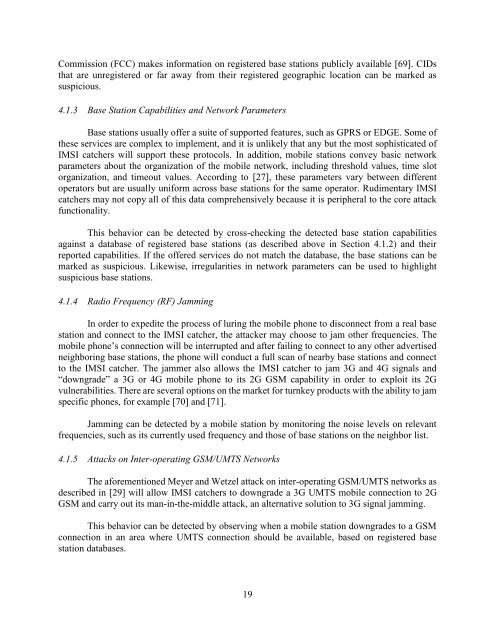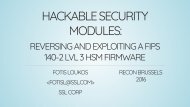IMSI Catchers and Mobile Security
EAS499Honors-IMSICatchersandMobileSecurity-V18F-1
EAS499Honors-IMSICatchersandMobileSecurity-V18F-1
Create successful ePaper yourself
Turn your PDF publications into a flip-book with our unique Google optimized e-Paper software.
Commission (FCC) makes information on registered base stations publicly available [69]. CIDs<br />
that are unregistered or far away from their registered geographic location can be marked as<br />
suspicious.<br />
4.1.3 Base Station Capabilities <strong>and</strong> Network Parameters<br />
Base stations usually offer a suite of supported features, such as GPRS or EDGE. Some of<br />
these services are complex to implement, <strong>and</strong> it is unlikely that any but the most sophisticated of<br />
<strong>IMSI</strong> catchers will support these protocols. In addition, mobile stations convey basic network<br />
parameters about the organization of the mobile network, including threshold values, time slot<br />
organization, <strong>and</strong> timeout values. According to [27], these parameters vary between different<br />
operators but are usually uniform across base stations for the same operator. Rudimentary <strong>IMSI</strong><br />
catchers may not copy all of this data comprehensively because it is peripheral to the core attack<br />
functionality.<br />
This behavior can be detected by cross-checking the detected base station capabilities<br />
against a database of registered base stations (as described above in Section 4.1.2) <strong>and</strong> their<br />
reported capabilities. If the offered services do not match the database, the base stations can be<br />
marked as suspicious. Likewise, irregularities in network parameters can be used to highlight<br />
suspicious base stations.<br />
4.1.4 Radio Frequency (RF) Jamming<br />
In order to expedite the process of luring the mobile phone to disconnect from a real base<br />
station <strong>and</strong> connect to the <strong>IMSI</strong> catcher, the attacker may choose to jam other frequencies. The<br />
mobile phone’s connection will be interrupted <strong>and</strong> after failing to connect to any other advertised<br />
neighboring base stations, the phone will conduct a full scan of nearby base stations <strong>and</strong> connect<br />
to the <strong>IMSI</strong> catcher. The jammer also allows the <strong>IMSI</strong> catcher to jam 3G <strong>and</strong> 4G signals <strong>and</strong><br />
“downgrade” a 3G or 4G mobile phone to its 2G GSM capability in order to exploit its 2G<br />
vulnerabilities. There are several options on the market for turnkey products with the ability to jam<br />
specific phones, for example [70] <strong>and</strong> [71].<br />
Jamming can be detected by a mobile station by monitoring the noise levels on relevant<br />
frequencies, such as its currently used frequency <strong>and</strong> those of base stations on the neighbor list.<br />
4.1.5 Attacks on Inter-operating GSM/UMTS Networks<br />
The aforementioned Meyer <strong>and</strong> Wetzel attack on inter-operating GSM/UMTS networks as<br />
described in [29] will allow <strong>IMSI</strong> catchers to downgrade a 3G UMTS mobile connection to 2G<br />
GSM <strong>and</strong> carry out its man-in-the-middle attack, an alternative solution to 3G signal jamming.<br />
This behavior can be detected by observing when a mobile station downgrades to a GSM<br />
connection in an area where UMTS connection should be available, based on registered base<br />
station databases.<br />
19



